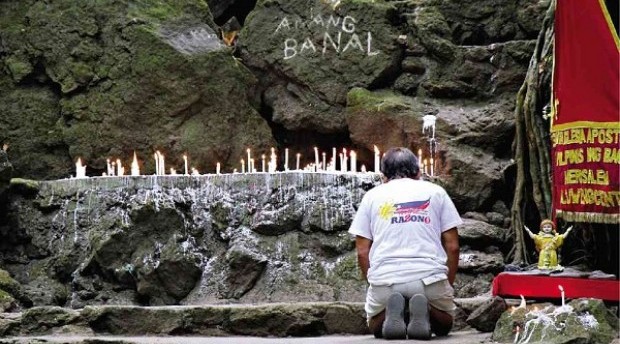Banahaw continues to lure pilgrims, trekkers

A DEVOTEE prays at one of the “sacred spots” on Mt. Banahaw in Dolores town, Quezon province. Viel Polintan/CONTRIBUTOR
DOLORES, Quezon—Authorities might have closed most parts of Mt. Banahaw but its devotees continued to come to pray, kiss its sacred ground, feel its cool, pristine water and enjoy its blissful serenity.
“This is our 10th year here on Mt. Banahaw,” said Julie Aguilar, 52, a tailoring shop operator in Cabuyao City, Laguna province.
Around her were five colorful tents that had been occupied by her children and relatives since Palm Sunday.
“We also pray, but we’re not religious pilgrims. We just come here to enjoy the peace. Sort of a nature trip,” she told the Inquirer.
Her husband Jun said he enjoyed the tranquility of the place. “At least for a week, we’re far from the maddening metropolis,” he said.
Article continues after this advertisementExcept for some areas at the foot of Banahaw, the rest of the mountain has been closed to the public since 2004 for rehabilitation.
Article continues after this advertisementThe base of the mountain in Kinabuhayan has been transformed into a camping ground for devotees, nature trippers and mountaineers.
The visitors enjoyed the gushing cool water of the Kinabuhayan River, but the Protected Area Management Board, which has supervision over Banahaw, prohibits the use of soap and shampoo in the area.
Holy mountain
The Dolores side of Banahaw, particularly the villages of Kinabuhayan and Sta. Lucia, is host to most of the “puestos (sacred spots),” which for the legions of pilgrims symbolize the holiness of the mountain.
In 1936, the late Agapito Illustrisimo, founded the religious sect “Tatlong Persona Solo Dios” and established a settlement in Kinabuhayan.
Some visitors, like Yolanda Tesoro, go to Banahaw for “divine” purposes.
For Tesoro, 67, a widow from Caloocan City, her annual visit to Banahaw was in obedience of the “whispered order” from an unseen woman she claimed was the “Mahal na Ina” or the Blessed Virgin Mary.
“I often come here because I was ordered by the Mahal na Ina to help me in my mission to heal the sick,” Tesoro said.
She arrived in Kinabuhayan on Palm Sunday aboard two jeepneys with more than 20 mostly women “apostles” from her organization called “Sagrada Pamilya.” They lit candles and read the passion of Christ along Kinabuhayan River.
“The people have to repent for their sins to escape the wrath of God,” Tesoro suddenly exclaimed during the interview.
“Suprema de la Iglesia Del Ciudad Mystica De Dios,” one of many religious sects based in Banahaw, observes Holy Week starting March 7 every year.
“We observe Good Friday every March 15. It’s a fixed date,” said Magtanggol Barrion, 51, a native of Sta. Lucia.
Daylong praying
The sect members pray the whole day in different puestos in a ritual they call “pamumuesto,” which Barrion described as similar to the Station of the Cross of the Catholics.
Anyone who joins the ritual is barefooted.
Most of the puestos, some of them landmarks, caves or waterfalls, were named after saints. A devotee has to squeeze his or her body through tight spaces to get inside, light candles and pray.
Barrion said they spent the whole day praying in one puesto and the next day in another puesto. They also fast during the ritual. “We bring only water and biscuit,” said Barrion, who works as a forest ranger on Banahaw.
A sect member has to bring a canister for his urine and waste during the whole day of prayers and bring it back with him as he leaves the puesto to show respect to the mountain spirits.
There are more than 100 known puestos scattered around Banahaw, according to Department of Environment and Natural Resources park area superintendent Salud Pangan.
The ritual takes seven to eight years for a devotee to complete, according to Alfredo Garcia, a Mystica member and village councilor of Sta. Lucia.
Garcia said that once a pilgrim completed the Holy Week rituals of praying at different “holy spots” located in the multiuse zone at the base of the mountain in Kinabuhayan and Sta. Lucia, a devotee should climb the mountain to also pray in different puestos at the peak to complete the spiritual journey. “It’s a must for the sect member to reach the top and pray,” he said.
Forbidden heights
But he claimed that no member of their sect had been to the peak since Banahaw’s closure in 2004.
On Maundy Thursday, hundreds came in cars, vans, SUVs, jeepneys and buses that lined up toward Sta. Lucia to pray before several puestos in the area.
Danilo Cuadra, 75, who walked with a cane and aided by his sons, got off from a van.
One of his sons said the old man’s wish was for them to bring him to Banahaw during Holy Week until his death.
In one of the puestos called “Altar ng Jerusalem,” two long-haired males in red robes were reciting prayers with fellow devotees.
Both claimed to be the spiritual personification of “Lolo Uweng” and “Lolo Simon,” both believed to be divine beings.
Despite the prohibition, Banahaw continues to lure pilgrims, mountaineers and nature trippers to scale its forbidden heights.
Veteran mountaineer Noel Suministrado explained that the peak and bosom of Banahaw, classified by hikers as a major climb, never fail to offer a myriad of natural attractions and challenges.